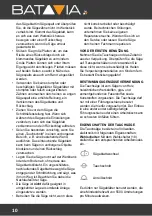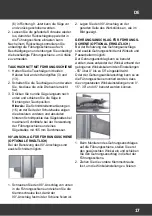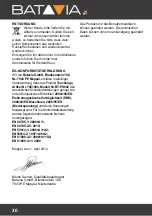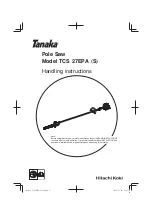
SAFETy InSTRUCTIOnS FOR PlUngE
SAWS
• Make sure that the mains voltage matches
the specifications on the type plate.
• Persons with restricted physical, sensory or
mental capabilities are not allowed to use
the circular saw unless they are supervised
and instructed by a guardian.
• Never leave the powered-on saw
unattended and keep them out of reach of
children and persons in need of
supervision.
• Use only approved extension cords with a
suitable cable quality.
• Do not bring your hands in the cutting area
and the saw blade.
• Wear appropriate work clothing as well as
eye protection, hand protection and hearing
protection. Always handle the saw blade
with gloves.
• Keep in mind that even a worn saw blade is
still very sharp. Always grasp the saw blade
on the sides. Do not fling the saw blade and
do not drop it.
• Never use the circular saw with grinding
wheels.
• Do not grip underneath the workpiece. The
protective cover cannot protect you from
the saw blade under the workpiece.
• Adjust the cutting depth to the thickness of
the workpiece. It should be visible less than
a full tooth height under the workpiece.
• Do not cut very small workpieces. When
cutting round wood, use a device which
secures the workpiece from twisting. Never
hold the workpiece to be cut in your hand or
across your leg. It is important to secure the
workpiece properly to minimise the risk of
physical contact, jamming of the saw blade
or loss of control.
• Hold the saw only by the insulated gripping
surfaces when performing an operation
where the cutting tool may come into
contact with hidden power lines or its own
device cable. Contact with a live wire also
exposes the metal parts to tension and
leads to an electric shock.
• When cutting longitudinally, always use the
parallel stop or a straight edge guide. This
improves the cutting accuracy and reduces
the possibility that the saw blade gets
jammed.
• Use always saw blades in the correct size
and with suitable locating bore. Saw blades
that do not match the mounting parts of the
saw will run unevenly and lead to loss of
control.
• Never use a damaged or incorrect outer
flange or a damaged clamping screw. The
outer flange and the clamping screw have
been specially designed for your saw for
optimum performance and reliability.
• Start the circular saw and begin cutting
when it reaches the full idling speed.
• Never brake the saw blade using lateral
pressure after switching it off.
• Set the saw aside only when the saw blade
comes to a standstill.
• Do not expose the saw to high
temperatures, humidity and strong shocks.
The saw can be damaged as a result.
CAUSES AnD PREVEnTIOn OF
KICKBACK
• A kickback is the sudden reaction as a
result of a stuck, jammed or misaligned saw
blade which leads to an uncontrolled saw to
be lifted and moved from the workpiece out
in the direction of the operator.
• A kickback can occur when the saw blade
gets stuck or jammed in the saw gap. The
saw blade is blocked and the motor force
repels the circular saw in the direction of
the operator.
• A kickback can occur when the saw blade
becomes twisted or misaligned in the saw
groove. As a result, the teeth of the back
23
EN
















































